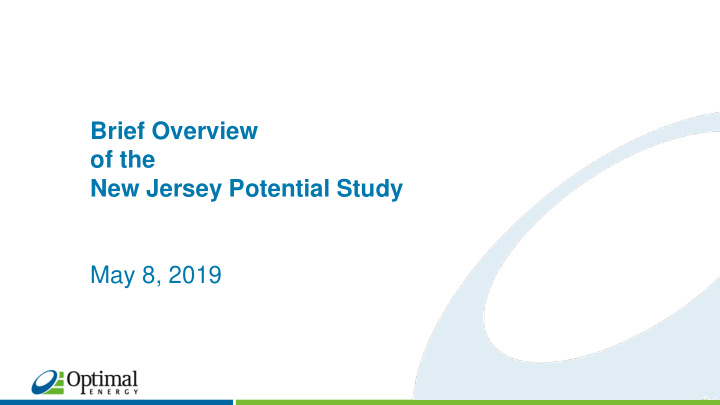



Brief Overview of the New Jersey Potential Study May 8, 2019
Legislation New Jersey’s Clean Energy Act of 2018 (the Act) specifies that: No later than one year after the date of enactment…, the board shall conduct and complete a study to determine the energy savings targets for full economic, cost-effective potential for electricity usage reduction and natural gas usage reduction as well as the potential for peak demand reduction by the customers of each electric public utility and gas public utility and the timeframe for achieving the reductions. [Emphasis added.] Delaware Energy Efficiency Advisory Council – May 8, 2019 2
Legislation Each electric public utility shall be required to achieve annual reductions in the use of electricity of two percent of the average annual usage in the prior three years within five years of implementation of its electric energy efficiency program. Each natural gas public utility shall be required to achieve annual reductions in the use of natural gas of 0.75 percent of the average annual usage in the prior three years within five years of implementation of its gas energy efficiency program. [Emphases added.] Delaware Energy Efficiency Advisory Council – May 8, 2019 3
Legislation The Act also directed the BPU to: … adopt quantitative performance indicators…for each electric public utility and gas public utility, which shall establish reasonably achievable targets for energy usage reductions and peak demand reductions… Delaware Energy Efficiency Advisory Council – May 8, 2019 4
Legislation The Act specifies that incentives and penalties shall be established and used: If an electric public utility or gas public utility achieves the performance targets established in the quantitative performance indicators, the public utility shall receive an incentive as determined by the board…. The incentive shall scale in a linear fashion…. If an electric public utility or gas public utility fails to achieve the reductions in its performance target established in the quantitative performance indicators, the public utility shall be assessed a penalty…. The penalty shall scale in a linear fashion… Delaware Energy Efficiency Advisory Council – May 8, 2019 5
Potential Study High-Level Findings Delaware Energy Efficiency Advisory Council – May 8, 2019 6
Cumulative Economic & Maximum Achievable Electric Potential by Sector, 2029 Preliminary Residential Residential Savings C&I Savings C&I Savings Total Savings Total Savings Year Scenario Savings (MWh) (% of Sales) (MWh) (% of Sales) (MWh) (% of Sales) Economic 7,575,463 23% 20,069,796 42% 27,645,258 34% Cumulative Energy, Potential 2029 Max Achievable 4,110,030 13% 12,749,878 27% 16,859,908 21% Potential (MW) (% of Load) (MW) (% of Load) (MW) (% of Load) Economic Cumulative Peak 2,798 Not Available 4,100 Not Available 6,898 33% Potential Demand Max Achievable Reduction, 2029 1,650 Not Available 2,512 Not Available 4,162 20% Potential Delaware Energy Efficiency Advisory Council – May 8, 2019 7 7
Maximum Achievable Potential, Energy Efficiency + Demand Response + Combined Heat and Power, Cumulative, 2029 Preliminary Electric Savings Electric Savings Demand (% of 2029 Energy (% of 2029 2029 (MW) a Demand) a Potential Component 2029 (MWh) Sales) Energy Efficiency 16,859,908 21% 4,162 20% Demand Response b - 0% 1,361 7% Combined Heat and Power 4,168,388 5% 476 2% Total 21,028,296 26% 5,999 29% a The energy efficiency and demand response analyses were performed in isolation, so while the peak demand impacts are totaled in this summary table, in reality, they are not purely additive as potential interactions between the two were not considered. b The demand response impacts presented in this table are quantified at generation. Delaware Energy Efficiency Advisory Council – May 8, 2019 8 8
Implications for Efficiency Programming Delaware Energy Efficiency Advisory Council – May 8, 2019 9
Legal Requirements BPU to establish “reasonably achievable targets” For annual energy use and peak demand reductions (electric and gas) Savings can include all efficiency initiatives, including, but not limited to: – Utility administration of energy efficiency programs – Non-utility efficiency efforts ( e.g., code changes, appliance efficiency standards, other State-sponsored initiatives, etc.) Delaware Energy Efficiency Advisory Council – May 8, 2019 10
Electric Net Annual Statewide Energy Savings Targets Preliminary Net annual Net savings targets Year incremental savings (% of load) targets (GWh) 2020 0.75% 568 2021 1.10% 833 2022 1.45% 1,100 2023 1.80% 1,369 2024 2.15% 1,645 Delaware Energy Efficiency Advisory Council – May 8, 2019 11 11
Recommended Performance Incentives and Penalties Delaware Energy Efficiency Advisory Council – May 8, 2019 12
Guiding Principles for PI Mechanisms Performance-based Multivariate Scalable Measurable and objective Include countervailing-influence metrics to address secondary policy objectives and encourage a balanced portfolio Delaware Energy Efficiency Advisory Council – May 8, 2019 13
Questions / Discussion Eric Belliveau belliveau@optenergy.com 802-238-1229 Delaware Energy Efficiency Advisory Council – May 8, 2019 14
Recommend
More recommend